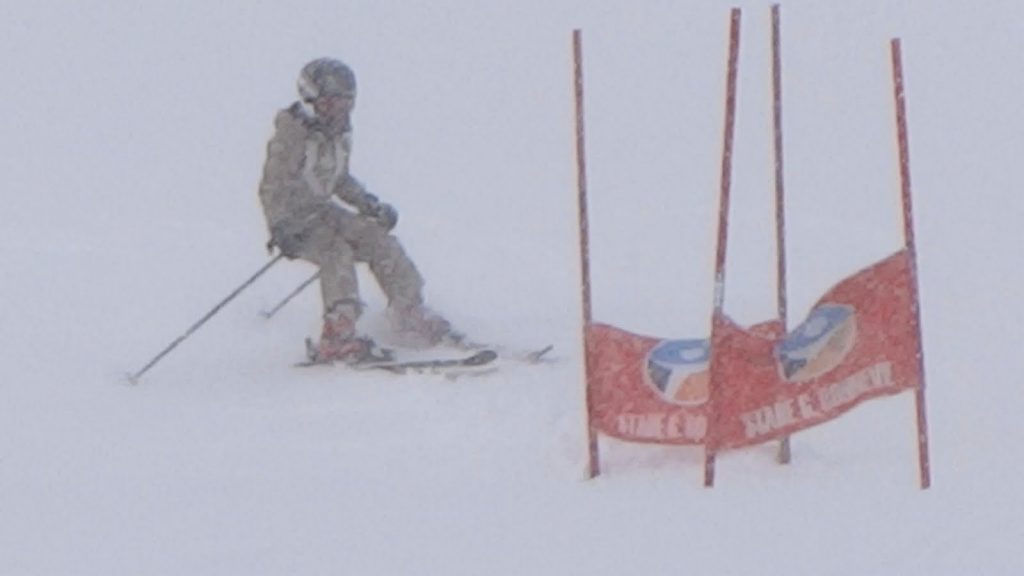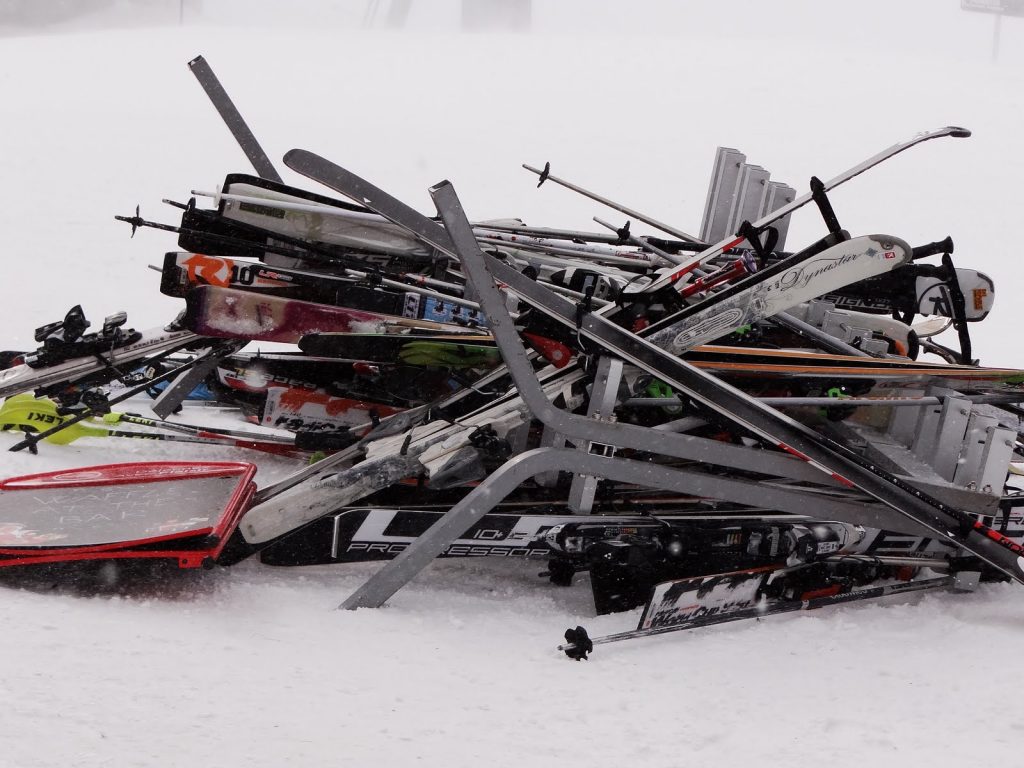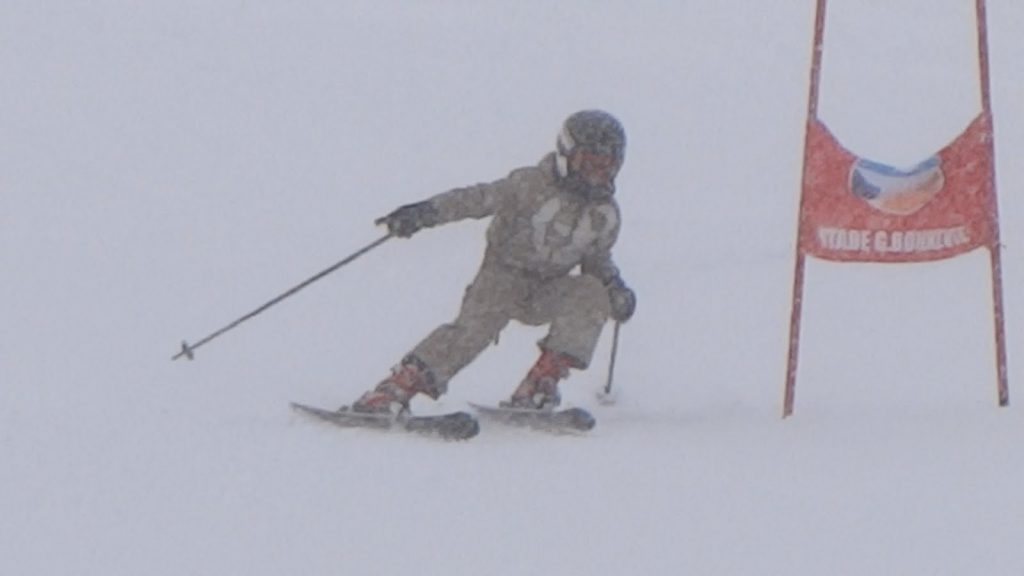JJ had finally succumbed to his fever and was forced to stay indoors against his wishes. Alex had not slept all night for worrying about the imaginary “threat” of skiing down a black run – which was not on the agenda -and could not be persuaded to ski voluntarily. Tariq then ended up with one-on-one coaching.
The weather was foul but with the direction of the wind this meant that the slalom training area would be sheltered and so we headed straight there.
Tariq
Slalom
Tariq was quick to understand the rules of how to use the slalom so there was no time wasted there. The only instruction he was given was to use dynamics and to see each gate (poles) as the centre of the turn he would be driving his centre of mass down and inwards towards. In only four runs on his own he managed to reduce his time by 4 seconds from 44.15 to 39.31. We had made breaking 40 seconds the target. After his first run I told Tariq to make an arc coming in closer to the poles – but not to take a straight line to the pole – and to fight to keep his body down and into the centre of the turn during the second half of the turn when the forces build up and try to bring him up and out of the turn too soon. Tariq responded correctly and became significantly faster.
After the slalom we went up to the Tovière to warm up with a hot chocolate and to study the video. Tariq could see how much he was stuck on the back of his ski boots and how difficult this was making things for him. Outside the wind was fierce enough to have blown over practically anything that wasn’t tied down…

Leaning against the back of the boots.
Good dynamics here.
Legs too far apart.
After the hot chocolate we went for a long ski right down to the bottom – working on using the feet and touching the front of the boot with the shin. The pressure was to be just in front of the heels and the feet had to rock in the direction of the turns. I explained to Tariq that when a bicycle turns it’s because the front wheel changes direction changing the shape of the bicycle. Likewise it’s the front of a ski that controls turning so if all the weight is at the back it’s much harder to turn. Tariq felt an improvement in control with this. So far everything had been about “dynamics” and racing turns – so when at lower altitude and sheltered by the trees I found a place where we could focus for a while on pivoting skills.
Bumps
In the bumps Tariq was forced to keep his skis much closer together – not just because of pivoting but because the steepness of the bumps makes it practically impossible to ski with the legs wide apart. Despite the steepness Tariq was able to swing the front of his skis inwards beneath him on each drop from a bump. When placed on the uphill shoulder of a bump both the tips and tails of the skis are in the air so the ski can pivot much more easily – but it takes nerve to pull the ski in beneath you instead of pushing the heels outwards.
Off-Piste
Tariq skied down the steepest parts of the Face de Bellevarde black run without ever realising that it was supposed to be difficult. That was the case until we deviated off-piste and he found a large “drop off” – where he promptly dropped off head first down the hill. Luckily I was not far below so was able to recover the skis. The hidden desire to swim in the snow displayed itself again on our second foray off-piste – this time caught by the camera. Brave Tariq climbed back up by himself to recover his ski. His fall in both instances was mostly caused by apprehension and leaning back against the boots again.
Skating Rhythm
We worked a little on skating – and relating the dynamics to skating rhythm – independent use of the legs and linking the power of the push up with the dynamics at the end of the turn. Tariq had a good natural feel for this.
Joydip
Joydip had not been out on skis again since his first venture two days ago but we were able to pick things up where we had left them without any bother.
Relaxation
People think that relaxation is easy but it’s often hard work – you have to make yourself relax. Joydip’s skis were still slithering about when he tried to grip for skating and his coordination was not consistent so it became pretty obvious that the real issue was tension.
Joydip was trying to balance against the back of his ski boots and tensing most of his muscles in the process. Focusing on relaxing muscles and carefully, attentively feeling the movements of the legs gradually allowed the coordination to improve.
The standard solution for this situation is to jam the skier into a defensive snowplough and forget about everything else. For me it was extremely important to avoid any temptation to introduce the snowplough – it was effectively banned. Gradually Joydip started to relax and move with more confidence – first mastering the button lift and then both skating step turns and parallel turns though rolling the feet and moving the centre of mass. Unfortunately I missed filming his last ascent where he went a bit higher and did a perfect parallel turn at speed, bringing it to a controlled stop at the bottom. Not a snowplough in sight.
The first descent from sightly higher up the hill had Joydip being left behind in his boots with the acceleration so I explained how to adapt to this. It’s absolutely NOT a question of “leaning forwards”. Standing on the flat you are vertical to gravity and you feel the reactive (elastic) force of the ground at 100% through your feet. If the gradient was 45° then by standing perpendicular to the slope only 50% of the force would be felt under the feet – and 50% would be converted into acceleration (eventually balanced by wind resistance). The point is that although you are now tilted at 45° and not vertical you feel exactly the same in every way – except that the pressure under the feet is reduced. You don’t “lean”. Whether you are in space or on the Earth you are effectively in a state of “free float” – and only the elastic resistance of the Earth interferes with it. It’s too late to get into Einstein’s relativity for tonight though.





